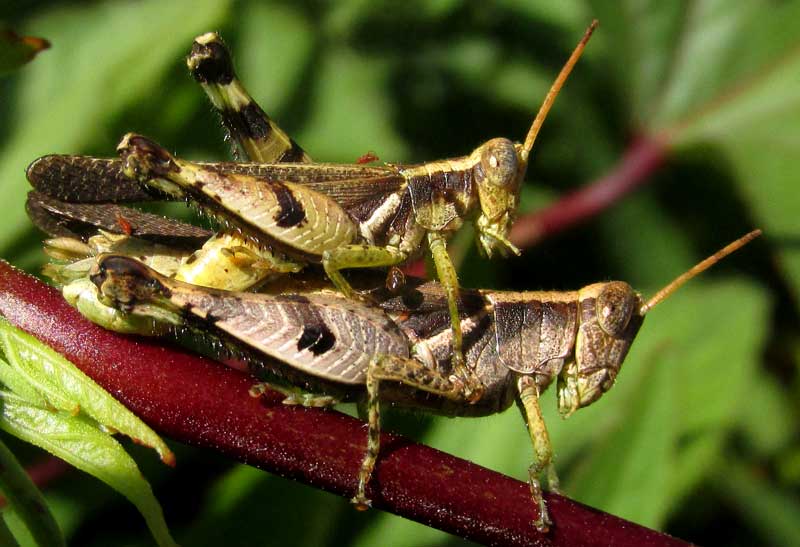Excerpts from Jim Conrad's
Naturalist Newsletter
from the September 6, 2018 Newsletter issued from Rancho Regenesis in the woods ±4kms west of Ek Balam Ruins; elevation ~40m (~130 ft), N~20.876°, W~88.170°; central Yucatán, MÉXICO
VALLADOLID'S GRASSHOPPER
I needed a general picture of a grasshopper, so I went into the garden and photographed the first grasshopper I saw. It turned out to be a mating pair, as you can see below:

Of course I wondered which species it was, so on the Internet I looked for pictures matching ours. The only match found was identified as "LACTISTA PELLEPIDUS, possibly?"
That's not much of a solid identification, and no information was given about the species, so I looked further. But, there were no matches, despite our grasshopper displaying some good field marks, especially the white streak originating at the base of the hind leg and directing diagonally toward the grasshopper's front. It seems our grasshopper is one of the lesser-known ones. The genus Lactista resides in the big Band-winged Grasshopper Subfamily, the Oedipodinae.
The only extra information I could find about the species was that it was named in 1884 by someone called Saussure and -- here's the nice part -- the species' "lectotype" had been collected in or around Valladolid, the fair-sized town about 10 miles (18kms) south of the ranch.
A lectotype is the preserved specimen on which the species' formal scientific description is based. When there's a lectotype, the assumption is that the "type" of the first specimen collected and described is lost or maybe so ambiguously identified that later a qualified specialist "elects" a specimen to serve as a lectotype, and publishes information on that specimen. Some older types are so sketchily identified that it's unclear even from which continent or century they originated. The lectotype specimen for our Lactista pellepidus consisted of just one sex, so it's conceivable that with our photo we're publishing for the first time the appearance of the undescribed sex.
This all reminds us how tricky this naming business can be, even for specialists, plus, once again we see that here in the Yucatan even today a non-specialist like myself can find some pretty interesting things. You may remember how one of my snake pictures turned out to show a new species. Just this week a researcher at Florida International University publishing on the cactus genus Pilosecereus in the Caribbean region wrote saying that some consider our Yucatan <[>Pilosocereus gaumeri cacatus to be just a form of a more widely distributed species, but that my pictures convince him that it's really a distinct species. Those pictures are at www.backyardnature.net/yucatan/sabucan.htm
Finally, in our picture of the mating grasshoppers, did you notice the little red invertebrate atop the top grasshopper apparently parasitizing him? The picture reminds me of a poem written in 1733 by Jonathan Swift, sent to me a while back by volunteer bug identifier Bea Ontario:
“So, naturalists observe, a flea
Has smaller fleas that on him prey;
And these have smaller still to bite 'em,
And so proceed ad infinitum.”